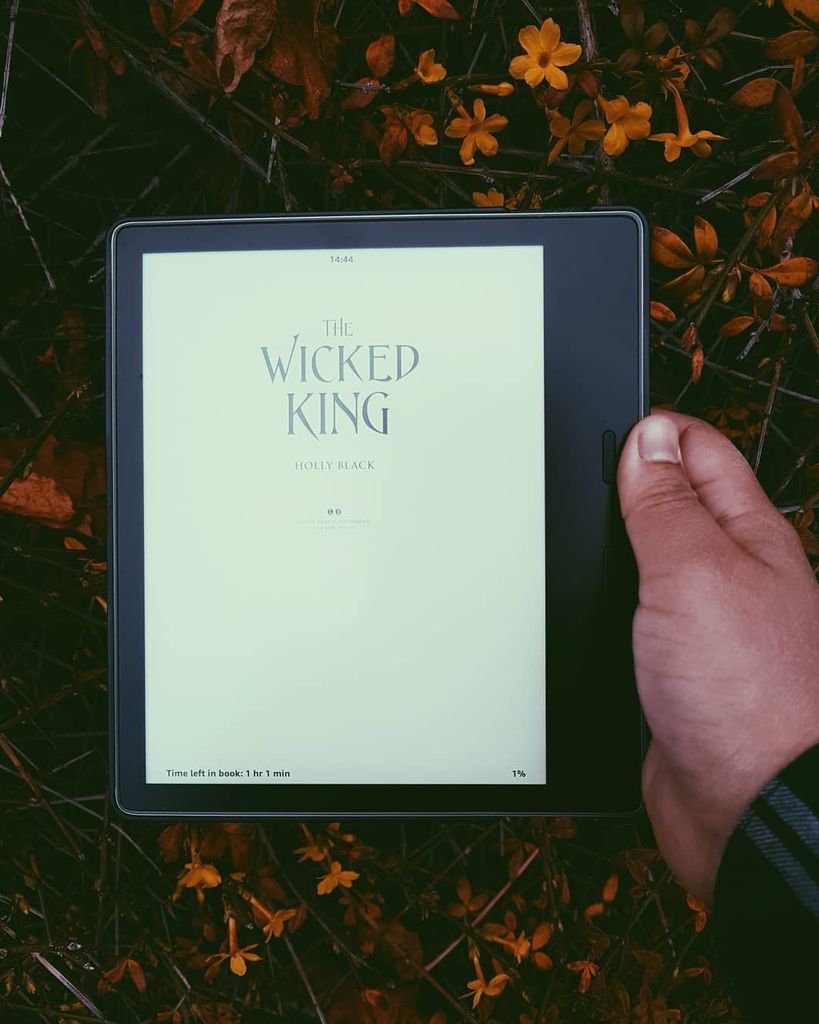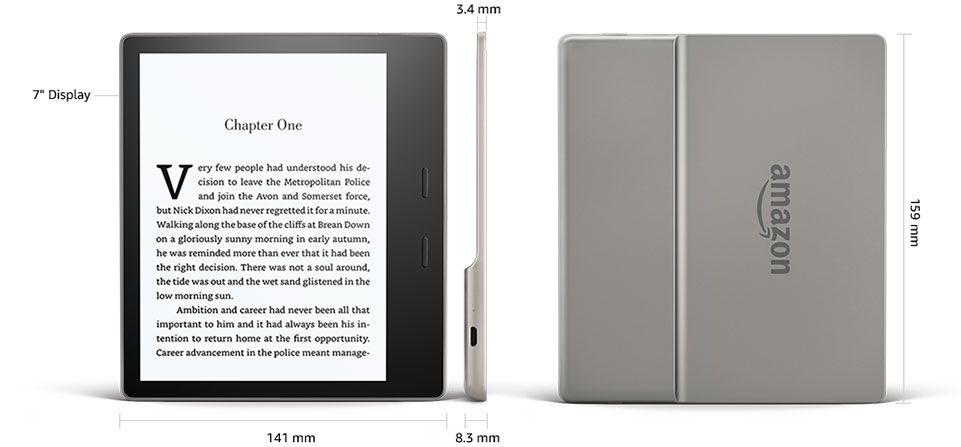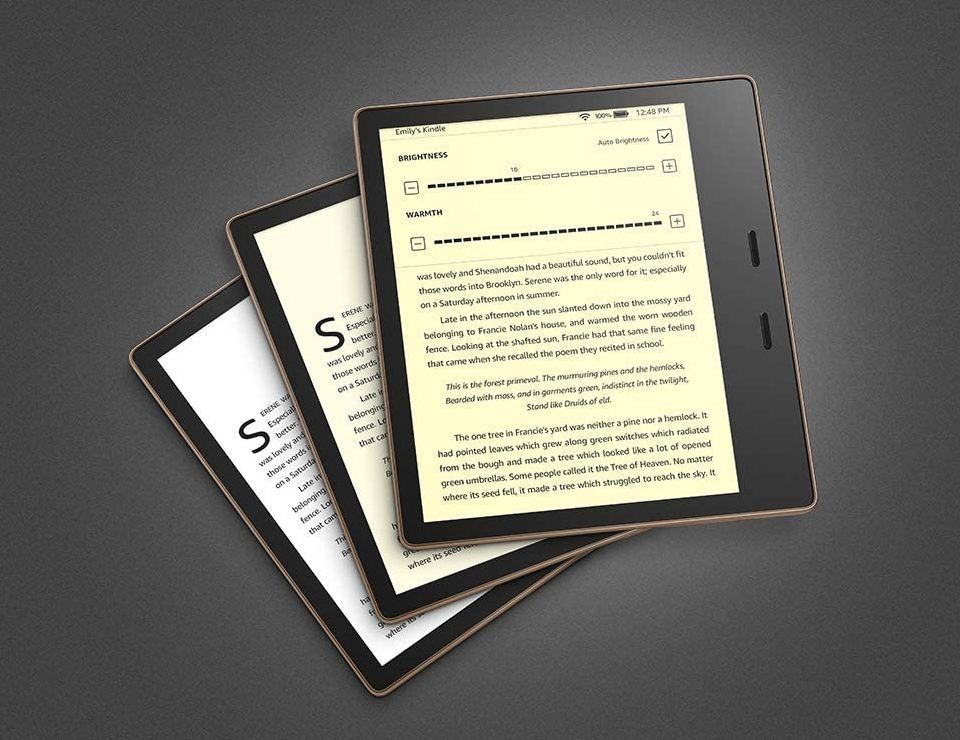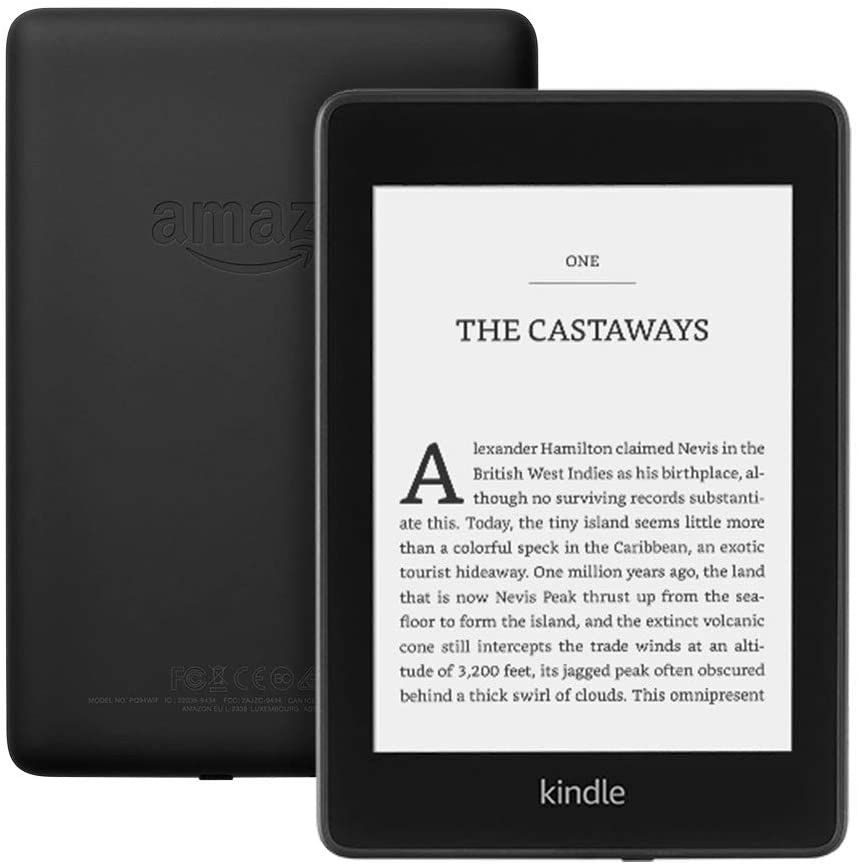
Yes: it’s expensive. In fact, it’s one of the most expensive e-readers around. But what my review will be examining today is whether or not it’s actually worth it. After all, there tons of cheaper e-readers out there, like the Paperwhite, also sold by Amazon.
I’ve been using various Kindle devices for about a decade, dating back to when my dad first bought the Kindle Keyboard in 2010. It wouldn’t have won any prizes for beauty, but it got the job done. It actually still works, which just goes to show that these things are built to last. Next in my lineup was the super-basic Kindle 8 I bought in 2016. It was literally just a flat plastic tablet with no buttons and a touchscreen. There was no built-in light in the touchscreen (Amazon does now offer this feature even in its entry-level models). I was happy with it, but its existence was abruptly terminated when I dropped it into the bath in 2017.
So for my eighteenth birthday, I got a ninth generation Kindle Oasis 2017. Then I sold it on eBay and upgraded to the tenth generation Oasis (2019), which now has the option to have a warm sepia tone to the screen, rather than plain white. There are also 25 embedded LEDs lighting up the screen rather than 12. On the outside, the two e-readers are identical. The picture below is of my last Kindle, but it looks exactly the same. So, I know what you’re thinking: WHY DID YOU UPGRADE IF THEY’RE BASICALLY THE SAME?
Is it worth upgrading from the Kindle Oasis 2017?
The short answer: not if you’re paying full price. I did the upgrade on Black Friday, when the price had been slashed by about £60. I would definitely not have upgraded otherwise. But since there was a discount, I do think it was worth upgrading. I’ll go into the reasons why later in this review.
It is, to put it bluntly, bloody expensive. The starting model, which has 8 GB storage, clocks in at £229.99 for the UK and $249.99 for the U.S. This increases to £260 and $280 respectively for 32 GB storage. The absolute max model – 32 GB plus free 4G connection so you don’t have to wait for WiFi to download books – will set you back by £320 or $350. For all but the last model, Americans will also have to pay an extra $20 not to have to see ‘Special Offers’. Those are basically ads that show up on the lock screen every time you close your Kindle. UK buyers are lucky here, since we don’t get those. (Not often UK buyers are luckier than Americans when it comes to electronics…)
⤅ Is it a good investment?
If you aren’t upgrading to this model from the Kindle Oasis 2017 (i.e. you don’t already have an e-reader, or you have another type of Kindle) I do think that price-wise, it’s a good investment for bookworms. Unlike with other electronics, your Kindle won’t become obsolete in a hurry. My old Kindle Keyboard still works perfectly after over a decade, and I have no reason to believe that either of my Kindle Oases wouldn’t have done the same. If you get this, you can expect to be using it for a good few years. Unlike with phones/laptops, e-readers don’t often have new models released; I think everyone was surprised when Amazon released a new Oasis after only two years. I don’t expect it to happen again, and the changes weren’t ground-breaking anyway.
⤅ What are the external features of the Kindle Oasis 2019?
As you can see from the image above, the Oasis’s most distinctive feature is its asymmetry. One side is raised in a hump to make one-handed reading easier. An internal gyroscope will flip the page around to accommodate for left-handed or right-handed readers, so you aren’t trapped gripping the device with a hand you don’t favour. The humped side also has two buttons to turn the pages.
In my opinion, the whole thing is very pretty. It’s made of a smooth cool brushed aluminium, and comes in the colours ‘graphite’ (AKA black) and ‘champagne gold’ (AKA pink). The metal can show fingerprints pretty easily, though, so I’d recommend adding a case. That’s also because you don’t want a £200-device smashing on the floor. The measurements are shown above, but for a real-life comparison, it’s about the length and weight of my Samsung S10. Essentially: it’s ridiculously light, very slim, won’t fit into a pocket but will fit almost everywhere else.
You may have noticed, however, that there’s no headphone jack. Listening to audiobooks has to be done via Bluetooth headphones. Also, a little irritatingly, it charges using a micro-USB port so I can’t use my phone’s USB-C charger on it.

⤅ Kindle Oasis 2019: What are the internal features?
Now, let’s talk about the internal features. The 7-inch square screen is backlit with 25 embedded LEDs, meaning you don’t have to rely on your own lights. It can be set to show white, black, or sepia-toned pages in varying shades of yellow. You can of course adjust the brightness, fonts, and font size. The Oasis also has all of the software features of its older siblings: dictionary definitions appear when you highlight a word, the Goodreads app is built in and there’s a clunky ‘Experimental Browser’. Nor are you limited to buying books available on the Kindle store: it’s possible to import your own e-books.
Don’t underestimate how nice the warm-coloured backlighting is. This is the biggest reason I upgraded. It’s a LOT more soothing on the eyes than the glaring bright whiteness of the last screen. As someone who reads a lot at night, this was something which I didn’t know I was missing until I found it. The lighting adjusts automatically, getting warmer/yellower in response to your surroundings and how late in the day it is, but you can also change this setting manually.
One thing you need never worry about is running out of storage space. Unless you listen to lots of audiobooks, which take up lots of megabytes, 8 GB will definitely be enough. Over the last two years I’ve only used up only a single gigabyte, despite downloading hundreds of books. Speaking of audiobooks: you can also store Audible purchases on your Kindle. If you’ve bought the corresponding ebook too, Whispersync means you can switch seamlessly between reading and listening. One will pick up where you left off with the other.
One thing I initially found annoying is the total lack of colour on covers. Since Kindles are e-readers, not tablets, they use e-ink technology, which means all covers are rendered in black and white. If you have particularly gorgeous covers on your books, too bad.
⤅ What’s the battery life like?
This is probably the weakest part of the whole Kindle Oasis package. Amazon advertises the device as lasting six weeks on a single charge, but that’s obviously garbage. It would only apply if you had the WiFi turned off, read for a solitary half-an-hour a day, and had the brightness at half-mast. If I read for about an hour a day, with WiFi on and regular brightness, it needs charging about every 4–5 days.
That’s still decent compared to the phone I charge daily, but it’s no six weeks.
⤅ Is the Kindle Oasis waterproof?
This is a question I was overwhelmingly interested in, seeing as how I killed one of my other Kindles by dropping it into the bath. The answer is yes: yes, the Kindle Oasis is waterproof. If you want to get technical about it, it has a waterproof rating of IPX8, which means it can withstand depths of over a metre and still come out fine. You probably won’t be going around leaving your Kindle submerged underwater for long periods of time, but it can definitely survive a brief drop in the bathtub.
⤅ Kindle Oasis vs Kindle Paperwhite
The biggest competition for the Kindle Oasis – at least from within Amazon’s own lineup of devices – is probably the Kindle Paperwhite. It’s the midrange model, being a step up from the basic Kindle. Here’s a head-to-head comparison below.
Price: At £120 (UK) or $130 (U.S.), the Paperwhite is obviously significantly cheaper. For British customers though, that’s with the Special Offers. Without Special Offers is £130.
External features: Huge differences. The Paperwhite comes in typical ereader shape: as you can see above, it’s a flat slab of a tablet, with a plastic back and no buttons. The 6-inch touchscreen is backlit with 5 LEDs and has the same resolution, at 300 pixels per inch. It’s 12 grams lighter and marginally smaller than the Oasis, so it’s more portable.
Internal features: Pretty much identical to the Oasis. There’s Bluetooth audio for audiobooks, which it didn’t have before.
Battery life: Not having one of these, I can’t personally contradict Amazon’s claim that the Paperwhite will last for up to six weeks if you read 30 minutes a day. But I’d take that with a pinch of salt. The battery life is probably a little better than my Oasis, so I’d say you’ll have to charge maybe every couple of weeks.
Waterproof status: The same. The Paperwhite is now also possessed of an IPX8 rating.
⤅ Should I get a Kindle Oasis?
The big question…
Ultimately, a lot of things have changed from when I bought my Kindle at the start of 2018. Back then, the Oasis was the only model with Bluetooth integration for audiobooks AND water resistance. Since those elements have been brought to the Paperwhite, the differences between them are now purely cosmetic.
I personally don’t regret my choice. As a book blogger, I do a LOT of reading, and the Oasis is definitely the most comfortable and stylish device on which to get through all my books. I also get a lot of ARCs, so I’m compelled to have an e-reader of some sort, and the Oasis is undoubtedly the most top-range e-reader on offer. I’m confident that it won’t become obsolete for at least the next decade or so, which makes it a worthy investment in my eyes – especially for the amount of use I get out of it. If those are all things which sound good for you, I’d say splash out. You can get them discounted on Black Friday, or people selling used versions on eBay.
But if you want a more traditional-looking e-reader, or you don’t read enough to justify the inflated price tag, go for the Paperwhite.




I have a Kindle Oasis 2017 and it’s served me well! Great post!
LikeLike
Thank you!! ❤
LikeLiked by 1 person
Woah that is expensive! I was thinking about getting one, since its definitely easier to read online than to read physical books, but since i do enjoy physical books more, I figure it would cost me less overall to just borrow the books or buy them when necessary. I don’t know though, maybe one day I might make the investment 🤔
LikeLiked by 1 person
I find that it’s mostly useful for reading e-ARCs! I agree that physical books feel nicer, but I think if you buy a lot of them the price stacks up quickly.
LikeLike
That’s true. I usually buy my books from charity shops, or from places that sell them cheaper, but even so I have a few hundred pounds worth of books 😅
LikeLiked by 1 person
[…] have the Kindle Oasis (reviewed here), and I probably won’t be upgrading straightaway, not least because I was forced to buy a […]
LikeLike